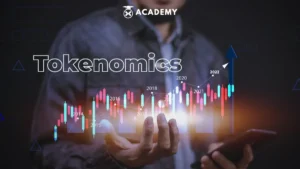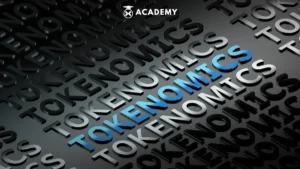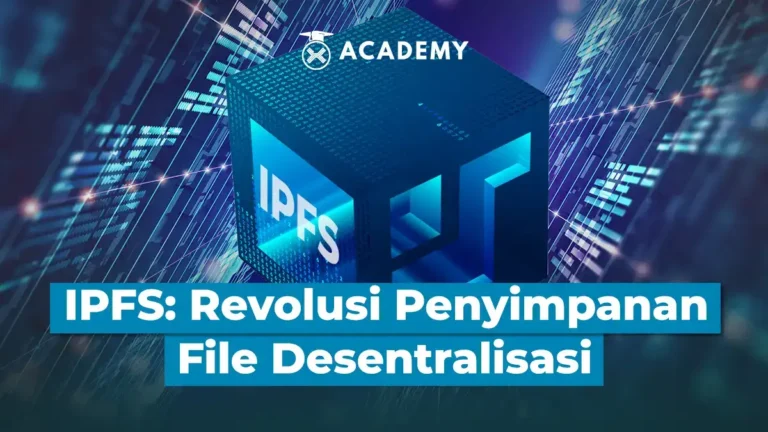Talking about crypto assets, of course, we are familiar with the term “token.” Apart from that, there is also a term known as “tokenomics.” Even though it is not yet widely known, tokenomics plays an important role in projecting the value of a crypto asset.
Tokenomics is a scientific discipline that examines the economic characteristics of crypto assets. It involves analyzing factors such as token supply, demand, and utilization.
As an integral part of the blockchain ecosystem, tokenomics covers the supply and demand aspects of tokens and the way those tokens interact within the blockchain network. Therefore, a deep understanding of tokenomics is important because it can provide insight into the value of a crypto asset and how it can contribute to the sustainability of the blockchain ecosystem.
So, to understand tokenomics, how it works on the blockchain, and its main features, components, and benefits, see the complete review below!
What is a Token in the Crypto World?
The term token refers to a digital asset developed over an existing blockchain network infrastructure. The process of creating tokens generally involves the use of smart contracts on a blockchain network, such as Ethereum.
In general, this token functions as a representation of a special asset or utility. For example, ERC-20 tokens are a popular type of token built on the Ethereum network. Some examples of well-known ERC-20 tokens include Tether (USDT) and Uniswap (UNI). Apart from that, there are also non-ERC-20 tokens created on top of other blockchain networks, such as Solana. The use of tokens varies greatly, ranging from functioning as a medium of exchange on certain platforms to representing ownership in a project or application.
What is Tokenomics?

Tokenomics, which comes from the words “token” and “economics,” is the study of the supply, demand, distribution, and valuation of crypto assets.
The definition of tokenomics covers all aspects, from the mechanism for issuing and burning a crypto asset to its utility and other aspects. It is a complex field of study and involves various scientific disciplines.
Investors study tokenomics to analyze whether a token has a sustainable economic design. A crypto asset can experience a decrease in value over time if its supply is too high or exceeds its demand. This phenomenon is known as “inflation”.
How Does Tokenomics Work on Blockchain?
Blockchain provides features that make crypto assets stronger than fiat currencies. Here’s how tokenomics works on the blockchain that you need to know:
1. Immutability
If we view blockchain like a city, then code is the law. The associated crypto assets have clearly defined tokenomics and cannot be arbitrarily changed. Any changes must involve a vote from the community. Therefore, no single individual (even the founder) has the power to change the decisions made from the start.
Let’s compare it with fiat money. The US dollar before 1972 was linked to gold, meaning the US could not print more money than the total value of its gold reserves. However, one day, to boost the economy, Nixon, then US President, decided to abandon his ties to gold. Since then, money has experienced artificial inflation or deflation through federal policy.
2. Transparency
Public blockchains provide an unmatched level of transparency for all transactions. It is one of the features of the distributed ledger that allows everyone’s participation in the game.
Imagine if you could monitor all whale activity and take precautions to protect your interests. If there is manipulation occurring then anyone has the opportunity to anticipate it.
Recently, the central bank increased interest rates by 1%, which became the highest single increase in history. This caused a massive decline in the stock and crypto markets. This happens often because when interest rates rise, it becomes difficult to borrow money. It was considered negative news for the industry, and people tried to keep their savings in liquid and safer investments. If, in some way, a retail investor can foresee this move (or have a say in the decision), then they can avoid a loss of wealth by reallocating their funds.
Tokenomics Key Features
After knowing how it works, it is also important to know the main features of tokenomics. The following is an explanation of its features, including:
1. Issuance
Issuance is the process of creating a new cryptocurrency that did not previously exist. Some important questions to ask when studying tokenomics include:
- How are tokens issued?
- What consensus method does its blockchain follow?
Take Bitcoin (BTC) and Ether (ETH) for this tokenomics study. The Bitcoin blockchain uses the Proof-of-Work (PoW) consensus method. New BTC coins are created whenever a miner adds a new block to the blockchain. New BTC enters circulation through miners at a predetermined rate. Meanwhile, the Ethereum blockchain uses the Proof-of-Stake (PoS) consensus method. Here, the validator locks 32 ETH for a chance to validate the transaction and create a new block. Based on their performance, newly created ETH is distributed to active validators at each epoch (approximately 6 minutes).
Other Layer 1 (L1) and Layer 2 (L2) tokens (e.g., Litecoin (LTC) and Cardano (ADA)) follow a similar issuance mechanism to BTC and ETH. However, not all cryptocurrencies have complex issuance mechanisms. Some projects create their entire token supply at the time of initial creation. These cryptos are usually sold in initial coin offerings (ICO).
2. Maximum Supply, Circulating Supply, and Market Capitalization
Tokenomics determines the maximum supply and circulating supply. A cryptocurrency can be designed to have a limited supply or an unlimited supply. For example, BTC has a limited supply of 21,000,000 coins, while ETH’s supply is unlimited.
BTC’s limited supply is considered one of its value propositions as it is considered a hedge against inflation and is also known as “crypto gold” due to its limited supply. The circulating supply of a token is the number of coins currently in circulation. A crypto asset’s market capitalization (or market valuation) equals the product of its unit price and circulating supply.
3. Distribution
Some crypto projects disclose in detail their token distribution and often involve distribution to early investors and venture capital as part of fundraising efforts and to founders and team members as incentives.
Tokens may be awarded in stages with vesting and cliff periods. This token emission can impact the token’s price when its holders decide to sell their shares in the market.
4. Burning
Burning is sending crypto to an unrecoverable wallet address to remove it from circulation. Burning tokens can help keep inflation at bay by reducing circulating supply.
Burning tokens can differ from one token to another. Projects may burn a certain percentage of their circulating supply at random or predetermined periods. Some blockchains, such as Ethereum, have coded burning of a portion of each transaction fee incurred by the user. Not all cryptos have a burning mechanism (for example, BTC). Some could even be upgraded to introduce a burning mechanism like Ethereum did in August 2019 with the “London upgrade.”
5. DeFi Incentives
Decentralized finance (DeFi) platforms offer users returns for locking their tokens in liquidity pools or staking pools. The process can affect the circulating supply of tokens, even reducing selling pressure.
Components of Tokenomics
Apart from providing incentives, several key components in tokenomics need to be considered. The following is an explanation regarding each component in tokenomics, including:
1. Token Distribution
Token distribution is an important factor in tokenomics. Crypto platforms must be able to distribute tokens to potential investors in a targeted manner. Mistakes in targeting can cause a token to be considered an empty entity due to lack of usage resulting in a loss of token value.
Because of this, platforms will usually choose to sell some of the token supply through an ICO to early investors or distribute tokens for free to miners who validate crypto transactions on their blockchain.
2. Price Stability
Tokenomics science is used to maintain token price stability. Crypto exchange platforms usually regulate the amount of token supply to avoid significant price fluctuations when large amounts of tokens are bought or sold by certain parties.
3. Business Scope
One important aspect of tokenomics is the business scope of a token. The utility or function of a token depends on the benefits it can provide to users or investors. Due to this, exchange platforms actively provide financial rewards and benefits to users who play a role in the governance of their blockchain and ensure the availability of a strong, secure network and adequate token circulation.
4. Governance
Through the application of the tokenomics model, platform governance can develop well. Platforms can set token minting periods, allocate voting and decision-making rights, offer incentives to prevent token hoarding and implement other policies to control token value.
5. Future Readiness Level
The success of tokenomics depends largely on understanding how token projects can overcome future challenges. Developers must consistently modify token technology and governance to ensure the project can thrive and survive over the long term.
Why is Tokenomics Important, and What are the Benefits?

Tokenomics refers to the design and framework that governs the distribution and functionality of tokens in a blockchain ecosystem. For crypto investors, understanding tokenomics is crucial for several reasons.
First, it provides insight into a token’s utility, demand, and long-term value proposition that will help investors assess its long-term value potential and the relationship of the token to the product being developed. Unfortunately, there are cases where a token is just a fundraising instrument but has no future use or value. Second, tokenomics can influence the scarcity or abundance of a token which can influence its price and adoption rate.
The distribution of tokens to various entities such as teams, early investors, advisors, or even cash reserves can significantly influence how certain stakeholders may influence the token price. Additionally, key periods and token issuances can provide an indication of possible price movements in the market. Furthermore, a well-structured token economy can strengthen network security, incentivize user behavior, and ensure the sustainability of a project.
Conversely, flawed tokenomics can lead to imbalances, potential manipulation, and, ultimately, failure of a crypto project. Therefore, a solid understanding of tokenomics is essential to make informed investment decisions in the rapidly evolving world of crypto.
What are the Factors Affecting Crypto Tokenomics?
Quoting mudrex.com, tokens are crypto assets created by project owners on the blockchain. Therefore, it is very important to understand that the founders of these projects can choose any model that suits them to generate these tokens. However, a wise investor must evaluate these models and understand the details of tokenomics to make an intelligent decision.
Here are several factors that influence crypto tokenomics that you need to know, including:
1. Token Distribution and Allocation
Web3 projects are fundamentally different from Web2 projects in terms of funding. While Web2 projects deal with equity or a percentage share of a business to raise money, Web3 projects often rely on tokens.
The money is raised using an ICO or Initial Exchange Offering (IEO). ICO or IEO is a new method of raising money. Projects launch their tokens and offer them at discounts in ICO/IEO sessions.
Therefore, it attracts enthusiastic investors. This is similar to an Initial Public Offering (IPO) in traditional finance. Since all funding is done through these tokens, they are designated for various aspects of the project. Token distribution describes the proportion in which different groups of users and investors own project tokens.
2. Token Supply
The maximum supply of a token plays an important role in its price movement. For example, Shiba Inu has a total supply of 1,000,000,000,000,000. Many people believe that someday the value could reach $0.01.
The ratio behind the thinking is that they are buying millions of tokens at a very cheap price. They believe they will become instant millionaires if the price reaches 1 cent.
However, if that happens, then it will reach a market capitalization (calculated by multiplying the current price and total supply) of $10,000,000,000,000. This is more than the market capitalization of the entire crypto industry today.
3. Model for Tokens
When exploring the tokenomics of a project, always think about the problem it aims to solve along with the use of the token. For example, would ETH be worth much if it wasn’t needed for every transaction that occurs on Ethereum?
Therefore, the greater the utility, the higher the probability of increasing demand and hence the probability of the value of the token increasing.
Likewise, pay attention to whether the token is inflationary (inflationary) or deflationary (deflationary). Often, deflationary tokens can serve as a store of value.
4. Market Capitalization
When evaluating a token, it is important to understand the dominance it brings to the entire crypto market. For example, Bitcoin dominance, a ratio of BTC market capitalization to total industry market capitalization, stands at around 50%. This ensures that fluctuations in Bitcoin are enough to change the market’s direction.
Likewise, the evaluated project should not be very insignificant regarding market capitalization. It’s the same as penny stocks in the stock market. It’s not always good if the price is cheap.
Tokenomics in Determining the Value of Crypto Assets
Tokenomics also serves as a guide to understanding how much an asset may be worth in the future. For example, many people new to crypto may think, “If this coin reaches a value as big as Bitcoin, then one day…” when that probably won’t happen.
For example, consider two coins, Bitcoin Cash and Tron. Bitcoin Cash has the same total supply as Bitcoin so thinking that it could one day have equal value has some legitimacy, it is possible. However, with over 100,000,000,000 Tron in circulation, for one coin to be worth thousands of dollars, Tron would have to be the highest-valued business in world history and how likely is that to happen?
While these questions may seem to require complex answers, they provide an additional way to look at crypto assets and help understand whether one asset is more likely to have a bright future than another.
Conclusion
In conclusion, tokenomics, which comes from a combination of the words “token” and “economics,” is the study of the supply, demand, distribution, and valuation of crypto assets.
The definition of tokenomics covers all aspects, from the mechanism for issuing and burning a crypto asset to its utility and other aspects. It is a complex field of study and involves various scientific disciplines. The way tokenomics works on the blockchain includes immutability and transparency. Meanwhile, the main features of tokenomics include issuance, maximum supply, circulating supply, market capitalization, distribution, burning, and DeFi incentives.
The role of tokenomics is not only related to the intrinsic value of a token but also to how economic models can strengthen project growth, attract investors, and ensure sustainability. Ultimately, a deep understanding of tokenomics is the key to making smart investment decisions and supporting the development of the crypto ecosystem as a whole.
Invest in Crypto Assets on INDODAX with Staking (EARN) Feature
So, now you understand what tokenomics is, how it works on the blockchain, and its main features, components, and benefits.
Next, if you are interested in investing in crypto assets with the crypto staking feature (EARN), choosing a safe and trusted crypto exchange on INDODAX would be a good idea.
?
Please remember that this crypto staking feature allows you to secure your crypto assets in a way that is similar to storing funds in a savings account. The crypto assets you lock through the INDODAX Earn feature will provide rewards, such as interest earned from savings.
It is important to note that the INDODAX Earn crypto staking feature can be accessed easily, anytime and anywhere, via the Mobile Application and desktop on the INDODAX website, especially on the INDODAX Earn crypto staking page.
Let’s start investing in crypto assets through the INDODAX crypto staking feature right now!








